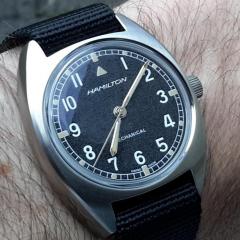Valjoux 7750: Rate Behaviour Question
-
Recently Browsing
- No registered users viewing this page.
-
Topics
-
Posts
-
By nevenbekriev · Posted
See, what has happen is a normal consequece of the reducing the hammer size and changing it's shape by the removing metal from it. But here the hammer is adjustable and just adjustment is needed to correct, and this is what You have done. There is a rule for the adjustment and it is that the hammer must lay firmly on the seconds counter heart and there should be a litle free play in the same time of the minutes counter heart/hammer which alows counter movement of about 0.5 min on the small dial hand (+/- 0.25). Of course, there is no way to make one hammer to delay from the other, as they are one single part. What has changed too is the slope of the hammer head and thus the orientation of the heart has changed, and thus the switching finger position. This led to need of the finger position correction. The rule here is that switching of the minute counter has to start when the seconds counter hand is on '59'. Of course, the seconds hand must be positioned as so the resetting is at '0' exactly. If switching is earlier than 59, there will be no problem, but it will be wrong as reading can be not correct. If the switching starts later, the problems that You described can happen. -
Thanks, This watch was in a box of old scrape units that a friend gave me. They used to be his late father's who was a watchmaker before the war and then continued later in life. I picked this one out as it looked like it had potential, and I liked the dial, it's been a bit of a learning curve for a beginner but I was determined to get it going. Now I'm on the final lap it feels good. I'm just wondering whether to invest in a decent set of hand placement tools or stick with the cheap Chinese red thing I have, decisions decision 😆
-
An update, for everyone who contributed advice, and for those who come after with a similar problem. Based on the answers received, I decided to work on the face of the hammer first. I used a square degussit stone to guarantee a vertical surface to work against, and ground the face back until it was square across 90% of the depth. I was conscious of the risk of removing too much material.* After I'd got the shape how I wanted it, I polished the surface with lapping film. To cut a long story short, it did the trick and the hammer hasn't slipped off the cam since. Of course, that wasn't the end of my problems. Have a look at this video and tell me what you think is wrong. https://youtu.be/sgAUMIPaw98 The first four attempts show (0 to 34 sec.) the chrono seconds hand jumping forwards, the next two attempts (35 to 47 sec.) seem "normal", then on the seventh attempt (48 to 54 sec.) the seconds hand jumps to 5 sec. and the minute counter jumps to 1. The rest of the video just shows repeats of these three variants. I solved it by rotating the minute counter finger on the chronograph (seconds) runner relative to the cam. I'd be interested to hear your opinions on that. It seemed to be the right thing to do, but maybe I've introduced another problem I'm not aware of. * What is the correct relationship between the two hammers and cams, by the way? Should both hammers strike the cams exactly at the same time, or is it correct for the minute counter hammer to be a bit behind the seconds hammer? In this picture, I removed the adjusting screw at 1, and the hammers are contacting the cams simultaneously at 3 and 4. I had to turn the screw down tight to achieve this condition after stoning the seconds hammer and replacing the bridge.
-
By ManSkirtBrew · Posted
It was easy enough to pop off. Once I had the cannon pinion hanging on the blades of the stump, I got my #2 tweezers on the gear attached to the staff and levered it down. That way none of the force was on the brass wheel itself. I reinstalled it and the bridge, and it looks like a small but reasonable amount of end shake. It also spins easily with a blower. It stops quickly, but I think that's due to the large shoulder and about what I'd expect from this wheel. -
Oh, right. For some reason I was picturing a monocoque case in my head. Good looking watch!
-







Recommended Posts